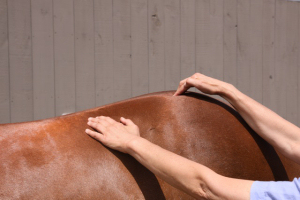|
Problem: Loss of Forward Motion at the Canter. Difficulty Coming Through from Behind. Sara called me to ask if I thought her horse needed her sacro iliac joint injected because her horse was not coming through from behind and seemed weak and stiff behind, resistant to canter freely. The vet was coming out in two days. I let her know that I could not determine if the horse needed to be injected, but I was happy to take a look at her horse and work on the mare after the vet examined her. Sara asked if I could come before the vet in order to loosen the horse up for the vetís examination. I accepted her request and saw the mare that day. Observation and Findings: After I watched the horse walk away from me and then toward me on a lead line, I could see the mare was not really stepping underneath with both hind legs. She seemed to be holding her lower back while she walked. Similar to the way a person walks with a stiff back. Little to no swing or ease in the walk. I began to palpate her major muscle groups with particular focus on her back and croup area. Her lower back was quite tight, and the area around her croup, was very tight. The tightness seemed to be stemming from the longissimus dorsi muscle where it attaches to the croup (sacrum). The gluteal muscles on both sides were quite tight as well. If there was an injury to a deeper structure, for example sacro iliac ligament, then the muscles would tighten around the croup area as a way to splint or protect the involved deeper structure. Solution:
I showed Sara how to work on her mare everyday using compressions and also recommended she obtain my latest online video massage training to continue to work specifically on her horseís back. I also recommended Sara canter the horse after my work to further lengthen the back and hindquarter muscles. Follow Up: Sara called and was thrilled with her mareís overall condition one week after I worked on the horse. Sara said the vet never made it to the farm due to a snowstorm, so Sara continued to massage the mare using the guidance of the online training videos I recently released. The videos are for horse owners or anyone who wants to learn and apply the Wilson Meagher Method of Sportsmassage. Once the vet made the barn call to assess the mare, the vet was very surprised at her findings. The vet determined that the mare was in very good shape and did not need any veterinary services. Both Sara and I were so pleased for the wonderful little mare!
|
 |


 I started with compressions to soften the
general muscle bellies along the mareís spinal muscles and
hindquarters. I worked on her neck and shoulders as well. After I
completed the compressions to both soften and widen the muscle
fibers, I went to where the longissimus dorsi attached to the sacrum
(croup). I applied direct pressure and cross fiber friction to both
left and right attachments and the entire gluteals and longissimus
dorsi (back muscles) relaxed. The tightness did not return after I
completed my sports massage treatment. I was a bit surprised because
I was led to believe the mare may have had a deeper structural
problem requiring a vet call. After I was finished with the
sportsmassage treatment, Sara trotted the mare out for me in a
straight line. The mare was sound and moved quite freely. Sara was
very impressed and happy with the outcome.
I started with compressions to soften the
general muscle bellies along the mareís spinal muscles and
hindquarters. I worked on her neck and shoulders as well. After I
completed the compressions to both soften and widen the muscle
fibers, I went to where the longissimus dorsi attached to the sacrum
(croup). I applied direct pressure and cross fiber friction to both
left and right attachments and the entire gluteals and longissimus
dorsi (back muscles) relaxed. The tightness did not return after I
completed my sports massage treatment. I was a bit surprised because
I was led to believe the mare may have had a deeper structural
problem requiring a vet call. After I was finished with the
sportsmassage treatment, Sara trotted the mare out for me in a
straight line. The mare was sound and moved quite freely. Sara was
very impressed and happy with the outcome.